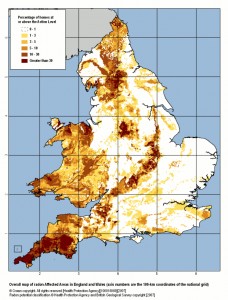Radon is not exclusive to the US or even Canada. The odorless, tasteless and colorless gas is released when certain elements undergo natural radioactive decay.
Radon is a decay product of both thorium and uranium – they happen to be the two most common radioactive elements on the planet. Believe it or not, the affected elements reside in the soil and ground beneath our feet. For that reason, radon is a danger everywhere. More and more of the deadly gas is released from the soil every second. This is how it seeps into homes and builds up inside.
Recently, we revealed the states in the US that are more susceptible to radon, as well as the areas of Canada most likely to see elevated levels. Those aren’t the only places in the world affected by the deadly radon gas. This time, we’re going to discuss how prevalent radon is in the UK – or more specifically England and Wales.
Is Radon a Problem in the UK?
Yes, it certainly is. Radon is responsible for more than 1,000 lung cancer deaths in the UK every year. For the most part, we’re led to believe that it is only a problem when the levels inside a residence exceed the recommended limit. In the UK, they measure levels of the gas in Becquerels per cubic metre or Bq/m³. The recommended action level, set by the Government Health Protection Agency, is 200 Bq/m³. In other words, if radon levels are found to be higher than that the homeowner should take action by installing a radon mitigation system.
A study conducted by S Darby, D Hill and R Doll in 2001 revealed that “around 90% of radon-induced deaths in the United Kingdom probably occur as a result of exposures to radon concentrations below the currently recommended action level of 200Bq/m³.” To put it bluntly, any amount of the deadly radon gas in a home can be dangerous to the inhabitants.
If you’d like to read the study, it is titled ‘Radon: a likely carcinogen at all exposures’.
What are the Effects?
Particles, called radon daughters, are released during the decay process. These particles cling to surfaces where they remain and continue to undergo radioactive decay. If they are inhaled, they stick to the inside of the lungs eventually leading to lung cancer. The risk of lung cancer is always higher in smokers who are also exposed to radon. To reiterate, that means if you smoke and have come into contact with radon gas your chances of contracting lung cancer increase exponentially.
Unfortunately, there are no short-term symptoms of radon poisoning or lung cancer. In fact, lung cancer symptoms won’t even show until the disease has progressed to a non-curable state.
 That is why it’s imperative you take action as soon as possible to measure the concentration of radon in your home. If the levels are found to be high, you should then hire a contractor to install a radon mitigation system.
That is why it’s imperative you take action as soon as possible to measure the concentration of radon in your home. If the levels are found to be high, you should then hire a contractor to install a radon mitigation system.
What Areas of the UK are More Susceptible?
This map offered by the Health Protection Agency reveals the areas of the country more susceptible to the deadly radon gas. The darker areas – as the legend states – have an increased percentage of homes above the recommended action level.
That being said, it is very important that you understand radon can exist anywhere. For that reason, we recommend all homeowners test their residence at least twice a year. You can also install a radon detector – similar to a smoke detector – that will continuously monitor the levels in your home.



